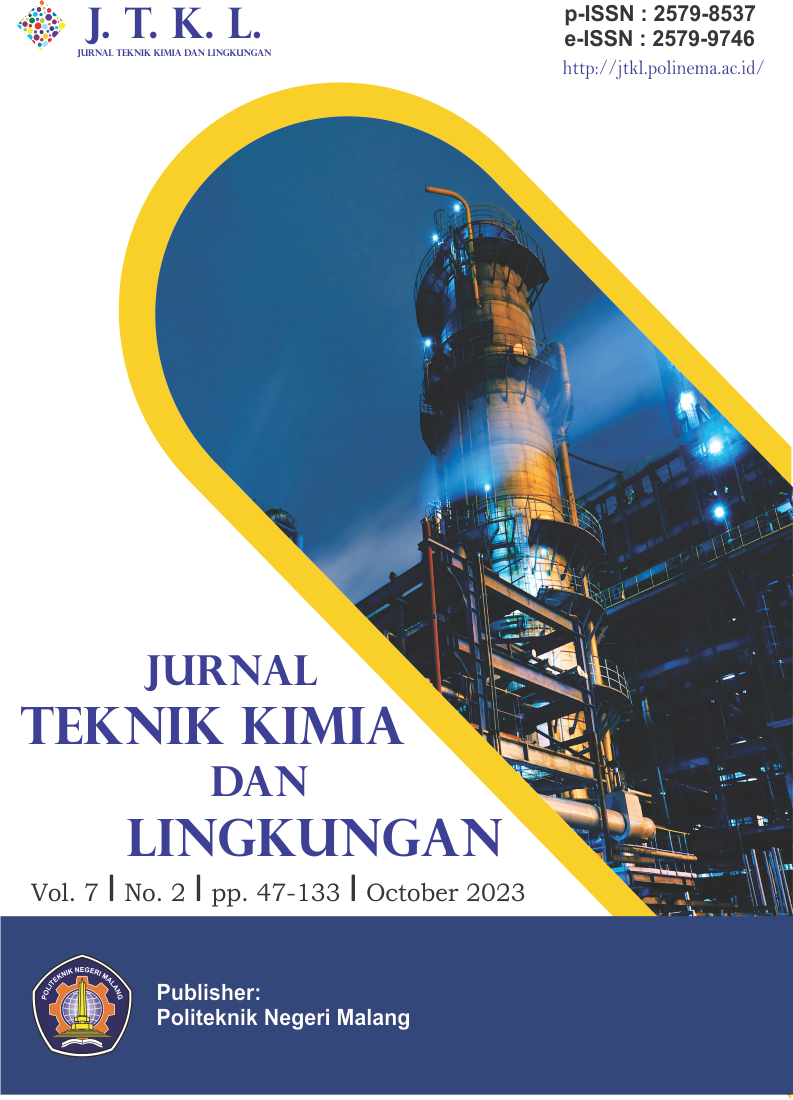Potential of Citronella Oil and Gum Rosin as Antimicrobial Agents in Floor Cleaner Liquid Against Salmonella thypi
DOI:
https://doi.org/10.33795/jtkl.v7i2.3737Keywords:
antimicrobial, citronella oil, floor cleaner, gum rosinAbstract
Some floor cleaner products on the market contain antimicrobial agents that are harmful to humans and the environment, such as benzalkonium chloride. Therefore, searching for a new antimicrobial agent that is relatively safe is a significant challenge. In this study, we investigated the best formula for making floor cleaner using citronella oil and gum rosin as antimicrobial agents. Its antimicrobial activity against Salmonella thypi was investigated and compared with that of a commercial floor cleaner containing benzalkonium chloride. Five concentrations and ratios of citronella oil and gum rosin were investigated. The quality of floor cleaner in terms of pH range and the stability of the emulsion in hard water was assessed according to SNI 06-1842-1995. The results showed that all formulas met the pH range required by SNI, except for formulas containing citronella oil alone. The emulsion in hard water was stable for all formulas. The antimicrobial activity increased with increasing concentrations of antimicrobial agents. Citronella oil exhibited higher antimicrobial activity than gum rosin. Benzalkonium chloride showed higher microbial activity than gum rosin but lower than citronella oil. The combination of citronella oil and gum rosin showed higher microbial activity by 1.1–2.4 times than formulas containing benzalkonium chloride. The optimum floor cleaner formula (a concentration of citronella oil and gum rosin of 2% with a ratio of 1:1) has an inhibition zone diameter of 22.2 mm.
References
Thermo Fisher Scientific, Safety Data Sheet of benzalkonium chloride, pp. 1–8, 2021, https://www.fishersci.com.
Sasol Chemicals (USA) LLC, Product Stewardship Summary Cresylic Acid, pp.1–7, https://www.sasol.com.
Sasol Chemicals (USA) LLC, Safety Data Sheet Ethoxylated Alcohol, pp. s1-11, 2020, https://sasoltechdata.com.
Sigma-Aldrich, Safety Data Sheet Pine needle oil, pp. 1–9, 2021, https://www.sigmaaldrich.com.
B. G. Cunhaa, C. Duqueb, K. S. Caiaffab, L. Massunarib, I. A. Catanozea, D. M. dos Santosa, S. H. P. de Oliveirac, A. M. Guiotti, Cytotoxicity and antimicrobial effects of citronella oil (Cymbopogon nardus) and commercial mouthwashes on S. aureus and C. albicans biofilms in prosthetic materials, Arch. Oral Biol., vol. 109, pp. 414–420, 2020.
J. Kim, M. R. Marshall, C-i Wei, Antibacterial activity of some essential oil components against five foodborne pathogens, J. Agric. Food Chem, vol. 43, no. 11, pp. 2839–2845, 1995.
M. Oussalah, S. Caillet, L. Saucier, M. Lacroix, Inhibitory effects of selected plant essential oils on the growth of four pathogenic bacteria: E. coli O157:H7, Salmonella Typhimurium, Staphylococcus aureus and Listeria monocytogenes, Food Control, vol. 18, no. 5, pp. 414–420, 2007.
F. N. Victoria, C. S. Radatz, M. Sachini, R. G. Jacob, D. Alves, L. Savegnago, G. Perin, A. S. Motta, W. P. Silva, E. J. Lenardão, Further analysis of the antimicrobial activity of α-phenylseleno citronellal and α-phenylseleno citronellol, Food Control, vol. 23, no. 1, pp. 95–99, 2012.
B. Teixeira, A. Marquesa, C. Ramosa, N. R. Neng, J. M. F. Nogueira, J. A. Saraiva, M. L. Nunes, Chemical composition and antibacterial and antioxidant properties of commercial essential oils, Ind. Crops Prod., vol. 43, no. 1, pp. 587–595, 2013.
M. Natsir, M. Nurdin, A. Ansharullah, M. Z. Muzakkar, E. Trimutia, I. Irwan, L. O. A. Salim, S. Salmah, M. Maulidiyah, The technique for separation and purification of gondorukem (gum rosin) from pine gum (pinus merkusii) with a simple distillation method, J. Phys. Conf. Ser., vol. 1899, no. 012038, 2021.
J. J. W. Coppen, G. A. Hone, Gum Naval Stores: Turpentine and Rosin from Pine Resin, Food and Agriculture Organization of the United Nations, 1995.
K. C. d. S. Rodrigues-Correa J. C. de Lima, A. G. Fett-Neto, Pine oleoresin: tapping green chemicals, biofuels, food protection, and carbon sequestration from multipurpose trees, Food energy Secur., vol. 1, no. 2, pp. 81–93, 2012.
A. Sukarno, A. Zairina, Y. Quarta, R. Kurniasari, S. Sumardi, A. S. Leksono, Yield and components of pine (Pinus merkusii) turpentine among age class differences tapping by borehole method, Indones. J. Environ. Sustain. Dev., vol. 11, no. 1, pp. 44–48, 2020.
A. Urzúa, M. C. Rezende, C. Mascayano, L. Vásquez, A structure-activity study of antibacterial diterpenoids, Molecules, vol. 13, no. 4, pp. 882–891, 2008.
A. Sipponen, Coniferous resin salve, ancient and effective treatment for chronic wounds: laboratory and clinical studies, Ph.D. Dissertation, Dept. of Orthopedics and Traumatology, Helsinki Univ., Helsinki, Finland, 2013.
I. Husna, S. Khaira, Pembuatan cairan pembersih lantai dari bahan alami buah lerak (Sapindus rarak DC) aroma sereh wangi, Proceeding of 4th International Conference on Education, pp. 149–152, 2019.
L. Humaira, S. Srikandi, Pemanfaatan potensi limbah kulit manggis dalam pembuatan pembersih lantai berbasis zero waste, J. IKRA-ITH Ekon., vol. 4, no. 2, pp. 69–72, 2021.
E. R. Desfitri, R. Desmiarti, S. Y. Verdana, A. Amanda, Pembuatan cairan pembersih lantai dengan memanfaatkan minyak atsiri dan hidrosolnya, React. J. Res. Chem. Eng., vol. 3, no. 1, pp. 28–35, 2022.
Clinical and Laboratory Standards Institute, Performance standards for antimicrobial disk susceptibility tests: Approved standard – 11th ed., CLSI document M02-A11, vol. 32, no. 1. 2012.
Badan Standarisasi Nasional, Standar Nasional Indonesia Pembersih lantai, SNI 06-1842-1995.
E. Buommino, A. Vollaro, F. P. Nocera, F. Lembo, M. DellaGreca, L. De Martino, M. R. Catania, Synergistic effect of abietic acid with oxacillin against methicillin-resistant Staphylococcus pseudintermedius, Antibiotics, vol. 10, no. 80, pp. 1–12, 2021.
M. Shuaib, A. Ali, M. Ali, B. P. Panda, M. I. Ahmad, Antibacterial activity of resin rich plant extracts, J. Pharm. Bioallied Sci., vol. 5, no. 4, pp. 265–269, 2013.
T. A. Söderberg, R. Gref, S. Holm, T. Elmros, G. Hallmans, Antibacterial activity of rosin and resin acids in vitro, Scand. J. Plast. Reconstr. Surg. Hand Surg., vol. 24, no. 3, pp. 199–205, 1990.
Downloads
Published
Issue
Section
License
Copyright (c) 2023 Wa Ode Cakra Nirwana, Chandrawati Cahyani, Vivi Nurhadianty

This work is licensed under a Creative Commons Attribution-NonCommercial 4.0 International License.







